Secrets of Antigravity Propulsion (55 page)

APPENDIX B
AVIATION STUDIES INTERNATIONAL LTD.
PUBLICATIONS
Publications Printed in 1960
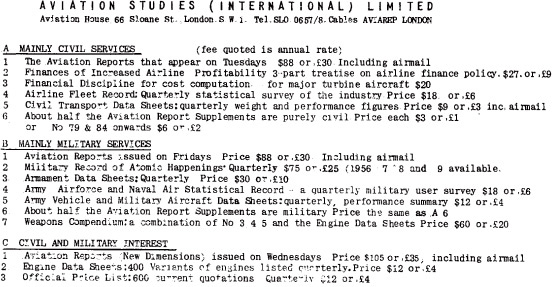
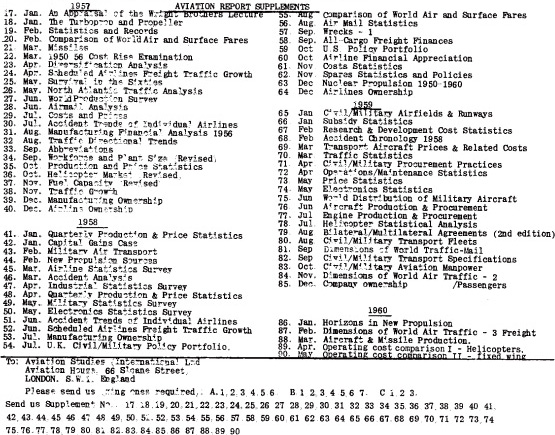
Publications Printed in 1993

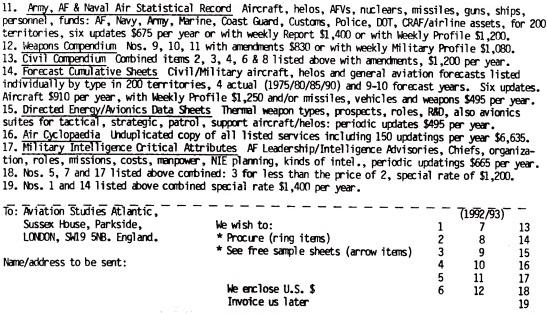
APPENDIX C
ELECTROGRAVITICS SYSTEMS
An Examination of Electrostatic Motion, Dynamic Counterbary, and Barycentric Control
The following excerpt is a reproduction of the Aviation Studies (International) Ltd.’s 1956 Gravity Research Group report entitled “Electrogravitics Systems: An examination of electrostatic motion, dynamic counterbary and barycentric control,” also known as “Report GRG-013/56—Electrogravitics Systems.”
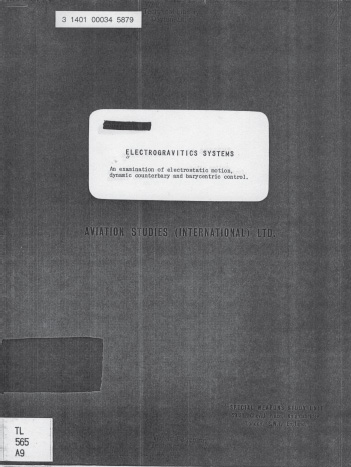
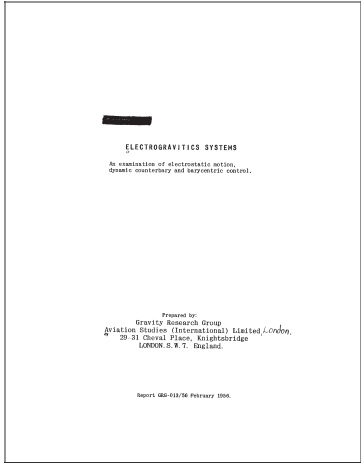
CONTENTS
It has been accepted as axiomatic that the way to offset the effects of gravity is to use a lifting surface and considerable molecular energy to produce a continuously applied force that, for a limited period of time, can remain greater than the effects of gravitational attraction.
The original invention of the glider, and evolution of the briefly self-sustaining glider, at the turn of the century led to progressive advances in power and knowledge.
This has been directed to refining the classic Wright Brothers’ approach.
Aircraft design is still fundamentally as the Wrights adumbrated it, with wings, body, tails, moving or flapping controls, landing gear and so forth.
The Wright biplane was a powered glider, and all subsequent aircraft, including the supersonic jets of the nineteen-fifties are also powered gliders.
Only one fundamentally different flying principle has so far been adopted with varying degrees of success.
It is the rotating wing aircraft that has led to the jet lifters and vertical pushers, coleopters, ducted fans and lift induction turbine propulsion systems.
But during these decades there was always the possibility of making efforts to discover the nature of gravity from cosmic or quantum theory, investigation and observation, with a view to discerning the physical properties of aviation’s enemy.
It has seemed to Aviation Studies that for some time insufficient attention has been directed to this kind of research.
If it were successful such developments would change the concept of sustentation, and confer upon a vehicle qualities that would now be regarded as the ultimate in aviation.
This report summarizes in simple form the work that has been done and is being done in the new field of electrogravitics.
It also outlines the various possible lines of research into the nature and constituent matter of gravity, and how it has changed from Newton to Einstein to the modern Hlavaty concept of gravity as an electromagnetic force that may be controlled like a light wave.
The report also contains an outline of opinions on the feasibility of different electrogravitics systems, and there is reference to some of the barycentric control and electrostatic rigs in operation.
Also included is a list of references to electrogravitics in successive
Aviation Reports
since a drive was started by Aviation Studies International Limited to suggest to aviation business eighteen months ago that the rewards of success are too far-reaching to be overlooked, especially in view of the hopeful judgment of the most authoritative voices in microphysics.
Also listed are some relevant patents on electrostatics and electrostatic generators in the United States, United Kingdom and France.
Gravity Research Group
25 February 1956
DISCUSSION
Electrogravitics might be described as a synthesis of electrostatic energy used for propulsion—either vertical propulsion or horizontal or both—and gravitics, or dynamic counterbary, in which energy is also used to set up a local gravitational force independent of the earth’s.
Electrostatic energy for propulsion has been predicted as a possible means of propulsion in space when the thrust from a neutron motor or ion motor would be sufficient in a dragless environment to produce astronomical velocities.
But the ion motor is not strictly a part of the science of electrogravitics, since barycentric control in an electrogravitics system is envisaged for a vehicle operating within the earth’s environment and it is not seen initially for space application.
Probably large scale space operations would have to await the full development of electrogravitics to enable large pieces of equipment to be moved out of the region of the earth’ s strongest gravity effects.
So, though electrostatic motors were thought of in 1925, electrogravitics had its birth after the War, when Townsend Brown sought to improve on the various proposals that then existed for electrostatic motors sufficiently to produce some visible manifestation of sustained motion.
Whereas earlier electrostatic tests were essentially pure research, Brown’s rigs were aimed from the outset at producing a flying vehicle.
As a private venture he produced evidence of motion using condensers in a couple of saucers suspended by arms rotating round a central tower with input running down the arms.
The massive-k situation was summarized subsequently in a report, Project Winterhaven, in 1952.
Using the data some conclusions were arrived at that might be expected from ten or more years of intensive development—similar to that, for instance, applied to the turbine engine.
Using a number of assumptions as to the nature of gravity, the report postulated a saucer as the basis of a possible interceptor with Mach 3 capability.
Creation of a local gravitational system would confer upon the fighter the sharp-edged changes of direction typical of motion in space.
The essence of electrogravitics thrust is the use of a very strong positive charge on one side of the vehicle and a negative on the other.
The core of the motor is a condenser and the ability of the condenser to hold its charge (the k-number) is the yardstick of performance.
With air as 1, current dielectrical materials can yield 6 and use of barium aluminate can raise this considerably, barium titanium oxide (a baked ceramic) can offer 6,000 and there is promise of 30,000, which would be sufficient for supersonic speed.
The original Brown rig produced 30 fps on a voltage of around 50,000 and a small amount of current in the milliamp range.
There was no detailed explanation of gravity in Project Winterhaven, but it was assumed that particle dualism in the subatomic structure of gravity would coincide in its effect with the issuing stream of electrons from the electrostatic energy source to produce counterbary.
The Brown work probably remains a realistic approach to the practical realization of electrostatic propulsion and sustentation.
Whatever may be discovered by the Gravity Research Foundation of New Boston, a complete understanding and synthetic reproduction of gravity is not essential for limited success.
The electrogravitics saucer can perform the function of a classic lifting surface—it produces a pushing effect on the under surface and a suction effect on the upper, but, unlike the airfoil, it does not require a flow of air to produce the effect.
First attempts at electrogravitics are unlikely to produce counterbary, but may lead to development of an electrostatic VTOL vehicle.
Even in its developed form this might be an advance on the molecular heat engine in its capabilities.
But hopes in the new science depend on an understanding of the close identity of electrostatic motivating forces with the source and matter of gravity.
It is fortuitous that lift can be produced in the traditional fashion and if an understanding of gravity remains beyond full practical control, electrostatic lift might be an adjunct of some significance to modern thrust producers.
Research into electrostatics could prove beneficial to turbine development, and heat engines in general, in view of the usable electron potential round the periphery of any flame.
Materials for electrogravitics and especially the development of commercial quantities of high-k material is another dividend to be obtained from electrostatic research even if it produces no counterbary.
This is a line of development that Aviation Studies’ Gravity Research Group is following.
One of the interesting aspects of electrogravitics is that a breakthrough in almost any part of the broad front of general research on the intranuclear processes may be translated into a meaningful advance towards the feasibility of electrogravitics systems.
This demands constant monitoring in the most likely areas of the physics of high-energy sub-nuclear particles.
It is difficult to be overoptimistic about the prospects of gaining so complete a grasp of gravity while the world’s physicists are still engaged in a study of fundamental particles—that is to say those that cannot be broken down any more.
Fundamental particles are still being discovered—the most recent was the Segre-Chamberlain-Wiegand attachment to the bevatron, which was used to isolate the missing anti-proton, which must—or should be presumed to—exist according to Dirac’s theory of the electron.
Much of the accepted mathematics of particles would be wrong if the anti-proton was proved to be non-existent.
Earlier Eddington has listed the fundamental particles as:
e.
The charge of an electron.
m.
The mass of an electron.
M.
The mass of a proton.
h.
Planck’ s constant
c.
The velocity of light.
G.
The constant of gravitation, and
λ.
The cosmical constant.
It is generally held that no one of these can be inferred from the others.
But electrons may well disappear from among the fundamental particles, though, as Russell says, it is likely that e and m will survive.
The constants are much more established than the interpretation of them and are among the most solid of achievements in modern physics.
Gravity may be defined as a small scale departure from Euclidean space in the general theory of relativity.
The gravitational constant is one of four dimensionless constants: first, the mass relation of the nucleon and electron.
Second is e
2
/hc; third, the Compton wavelength of the proton; and fourth is the gravitational constant, which is the ratio of the electrostatic to the gravitational attraction between the electron and the proton.
One of the stumbling blocks in electrogravitics is the absence of any satisfactory theory linking these four dimensionless quantities.
Of the four, moreover, gravity is decidedly the most complex, since any explanation would have to satisfy both cosmic and quantum relations more acceptably and intelligibly even than in the unified field theory.
A gravitational constant of around 10
-39
has emerged from quantum research and this has been used as a tool for finding theories that could link the two relations.
This work is now in full progress, and developments have to be watched for the aviation angle.
Hitherto Dirac, Eddington, Jordan and others have produced differences in theory that are too wide to be accepted as consistent.
It means therefore that (i) without a cosmical basis, and (ii) with an imprecise quantum basis and (iii) a vague hypothesis on the interaction, much remains still to be discovered.
Indeed some say that a single interacting theory to link up the dimensionless constants is one of three major unresolved basic problems of physics.
The other two main problems are the extension of quantum theory and a more detailed knowledge of the fundamental particles.
All this is some distance from Newton, who saw gravity as a force acting on a body from a distance, leading to the tendency of bodies to accelerate towards each other.
He allied this assumption with Euclidean geometry, and time was assumed as uniform and acted independently of space.
Bodies and particles in space normally moved uniformly in straight lines according to Newton, and to account for the way they sometimes do not do so, he used the idea of a force of gravity acting at a distance, in which particles of matter cause in others an acceleration proportional to their mass, and inversely proportional to the square of the distance between them.
But Einstein showed how the principle of least action, or the so-called cosmic laziness means that particles, on the contrary, follow the easiest path among geodesic lines and as a result they get readily absorbed into space-time.
So was born non-linear physics.
The classic example of non-linear physics is the experiment in bombarding a screen with two slits.
When both slits are open particles going through are not the sum of the two individually but follows a non-linear equation.
This leads on to wave-particle dualism and that, in turn, to the Heisenberg uncertainty principle in which an increase in accuracy in measurement of one physical quantity means decreasing accuracy in measuring the other.
If time is measured accurately energy calculations will be in error; the more accurate the position of a particle is established the less certain the velocity will be, and so on.
This basic principle of the acausality of microphysics affects the study of gravity in the special and general theories of relativity.
Lack of pictorial image in the quantum physics of this interrelationship is a difficulty at the outset for those whose minds remain obstinately Euclidean.
In the special theory of relativity, space-time is seen only as an undefined interval which can be defined in any way that is convenient and the Newtonian idea of persistent particles in motion to explain gravity cannot be accepted.
It must be seen rather as a synthesis of forces in a four dimensional continuum, three to establish the position and one the time.
The general theory of relativity that followed a decade later was a geometrical explanation of gravitation in which bodies take the geodesic path through space-time.
In turn this means that instead of the idea of force acting at a distance it is assumed that space, time, radiation and particles are linked and variations in them from gravity are due rather to the nature of space.
Thus gravity of a body such as the earth, instead of pulling objects toward it as Newton postulated, is adjusting the characteristics of space and, it may be inferred, the quantum mechanics of space in the vicinity of the gravitational force.
Electrogravitics aims at correcting this adjustment to put matter, so to speak, “at rest.”
One of the difficulties in 1954 and 1955 was to get aviation to take electrogravitics seriously.
The name alone was enough to put people off.
However, in the trade much progress has been made and now most major companies in the United States are interested in counterbary.
Groups are being organised to study electrostatic and electromagnetic phenomena.
Most of industry’s leaders have made some reference to it.
Douglas has now stated that it has counterbary on its work agenda but does not expect results yet awhile.
Hiller has referred to new forms of flying platform, Glenn Martin say gravity control could be achieved in six years, but they add that it would entail a Manhattan District type of effort to bring it about.
Sikorsky, one of the pioneers, more or less agrees with the Douglas verdict and says that gravity is tangible and formidable, but there must be a physical carrier for this immense trans-spatial force.
This implies that where a physical manifestation exists, a physical device can be developed for creating a similar force moving in the opposite direction to cancel it.
Clarke Electronics state they have a rig, and add that in their view the source of gravity’s force will be understood sooner than some people think.
General Electric is working on the use of electronic rigs designed to make adjustments to gravity—this line of attack has the advantage of using rigs already in existence for other defence work.
Bell also has an experimental rig intended, as the company puts it, to cancel out gravity, and Lawrence Bell has said he is convinced that practical hardware will emerge from current programs.
Grover Leoning is certain that what he referred to as an electro-magnetic contra-gravity mechanism will be developed for practical use.
Convair is extensively committed to the work with several rigs.
Lear Inc., autopilot and electronic engineers have a division of the company working on gravity research and so also has the Sperry division of Sperry-Rand.
This list embraces most of the U.S.
aircraft industry.
The remainder, Curtiss-Wright, Lockheed, Boeing, and North American, have not yet declared themselves, but all these four are known to be in various stages of study with and without rigs.
In addition, the Massachusetts Institute of Technology is working on gravity, the Gravity Research Foundation of New Boston, the Institute for Advanced Study at Princeton, the CalTech Radiation Laboratory, Princeton University and the University of North Carolina are all active in gravity.
Glenn L.
Martin is setting up a research Institute for Advanced Study which has a small staff working on gravity research with the unified field theory and this group is committed to extensive programs of applied research.
Many others are also known to be studying gravity, some are known also to be planning a general expansion in this field, such as in the proposed Institute for Pure Physics at the University of North Carolina.